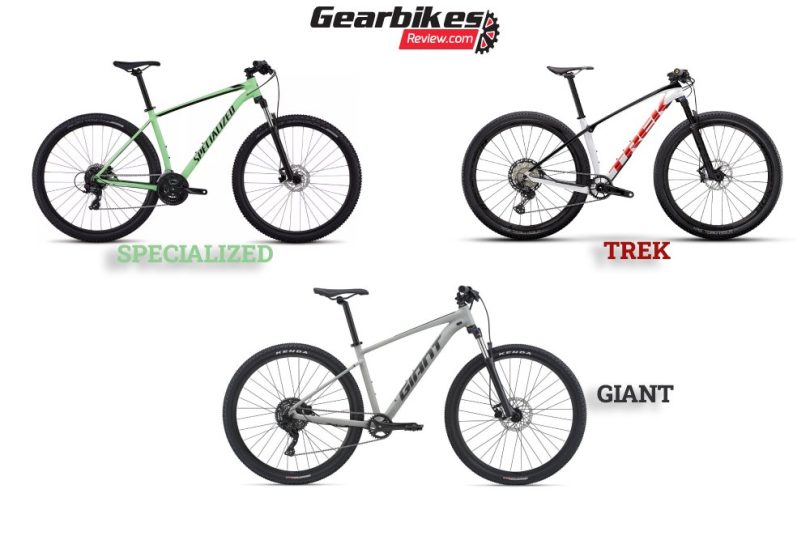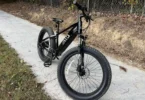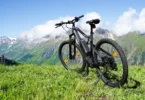Bikes are a versatile concept. We can ride them to work in the morning or we can throw them around a dirt trail at 70mph. Either way, you need the right bike for the job. So which brand is best?
The trifecta of bike manufacturers: Specialized, Trek, and Giant. Each continues to innovate in the industry and produce very high-quality bikes, with Giant being the largest bike company in the world.
What you drop the cash on depends on what you want and what you expect of each brand.
Specialized
Features
- High-end manufacturer
- Bikes for every rider
Pros
- High-quality aluminum manufacturing
- Broad product range
- Durable
Cons
- Expensive
- Big drop in quality at lower price ranges
- Third-party components
Trek
Features
- US-made
- Both entry-level and high-end models
- First-and second-hand warranty
Pros
- High-quality build
- Broad range of bikes
- Durable
- Low depreciation
Cons
- Expensive
- Higher chance of needing to upgrade certain components
- Certain models aren’t very customizable
Giant
Features
- Largest bike manufacturer in the world
- Bikes made for every kind of ride
- Innovative company with expertly crafted bikes
Pros
- Large variety
- Cheaper than other brands
- Quality build
- A go-to for mountain biking
Cons
- Some E-bike models suffer unreliability
- Rapid depreciation on most models
Specialized vs Trek vs Giant – What’s the Best?
1. Product range
Specialized
Specialized manufacture around 220 different bikes across 41 models, offering a bike for any situation whether it’s on-road, trail, electric, or fitness (among others).
Trek
Trek produces around 420 different bikes across 10 categories, with bikes for any road, mountain and trail, women and children, and so on.
Giant
Giant offers bikes across the subsets of:
- Road
- Mountain
- Cross and gravel
- Electric
- Kids
As the largest bike manufacturer globally, they have a large number of new and old bikes you can choose from.
Winner
It’s difficult to accurately say who offers the widest variety of bikes. Trek certainly produces many different bikes while Specialized clearly offers the broadest variety of models. Too difficult to decide in our opinion!
2. Brand Reputation
Specialized
Specialized is known for their high-end bikes and focus on the wealthy consumer. They have a strong presence in the trail and racing side of biking sport but have been marred with negative press in the past after taking up several lawsuits over copyright and intellectual property infringements.
Trek
Trek are seasoned race winners, with often more than double the race wins than their next competitor, Giant. They’re known for expensive bikes that push the edges of bicycle technology and dominate the North American market.
Giant
Giant hasn’t gotten to their position as a leader in bicycle manufacturing unliked. They’re a well-respected and heavily established producer of a wide range of simple and advanced bikes. Given their lower price range, they certainly appeal to a larger number of buyers.
Winner
Trek and Giant have seen little bad press over their lifetimes. Between the two, there’s barely a comparison.
3. Design
Specialized
Specialized, perhaps suggested by the name, is a high-end manufacturer. They place a lot of emphasis on bike design and technology, often catering more towards those without a money problem.
Trek
Trek is very focused on their R&D. Each new bike is an innovation, and it shows in the price and design of the bike. They optimize for everything and continue to push the boundaries of biking tech.
Giant
Giant tries to produce for the masses. They have had breakthroughs and continue to make them, but it’s easy to see that getting the bike off the factory floor is more important than keeping it in the design phase.
Winner
The design winner depends on what you’re looking for. If you want something unassuming, try Giant’s catalog. If budget isn’t a problem and technology is your deciding factor, Trek or Specialized are bound to have the bike for you.
4. Frame materials engineering and technology
Specialized
Specialized optimize their frames with SuperLight frame technology, making their alloy frames incredibly light and just as strong
Trek
Carbon fiber and aluminum technology is Trek’s focus. They use their proprietary OCLV carbon fiber manufacturing technique and alpha aluminum frames.
Giant
They use their innovative Aluxx aluminum in alloy frames and ACT (Advanced Composite Technology) in their carbon frames.
Winner
All three brands have impressive materials engineering employed in the manufacture of their bikes, though it seems Specialized lack a dedicated carbon fiber manufacturing process. Giant and Trek both win in their technology.
5. Brakes
Specialized
Specialized tend to use active braking (explained below), isolating the (often hydraulic) disc brakes from the suspension.
Trek
Trek solved the problem of interdependence between the brakes and the rear suspension where braking would lock the suspension with the Active Braking Pivot (ABP). ABP keeps the rear suspension working normally whenever the rider hits the brakes.
Trek will often use hydraulic disc brakes on most of their bikes.
Giant
Similar to Trek’s ABP, Giant uses their proprietary Maestro braking system that keeps suspension active while braking. They also tend to employ hydraulic disc brakes.
Winner
Each brand uses essentially the same technology, mostly spearheaded by Trek.
6. Suspension
Specialized
Specialized make use of smart suspension technology with adaptive stiffness depending on the terrain. Also, when it comes to their mountain bikes, Specialized uses Future Shock Rear (FSR) technology to smooth out the bumps.
Trek
Full-floater and RE:Aktiv suspension technologies are both hallmarks of Trek bikes. Pedaling with a full-floater is much smoother while RE:Aktiv gives you more power uphill.
Another of Trek’s suspension innovations is Active Pivot Point, giving you more clearance over obstacles.
Giant
Giant’s patented Maestro system is a useful piece of technology when it comes to pedaling power uphill and during a race.
Winner
As usual, Trek bikes are a technology hotbed, featuring many more innovations than their rivals.
7. Drivetrain
Specialized
- SRAM XX1 Eagle carbon crankset
- SRAM X01 Eagle 10-50t cassette
- Rear SRAM XX1 Eagle derailleur
- Fox Float 34 Factory FIT4 fork
Trek
- 130mm travel length
- 12 speed SRAM XO1 crankset
- Float 36 Grip 2 fork on an SRAM XG-1275 Eagle 10-50t cassette
- Rear SRAM Eagle Dub derailleur for incredibly smooth gear shifts
Giant
- 12-speed SRAM SX Eagle gear
- 11-50t cassette and SRAM SX Eagle Dub crankset
- Radon 34 Boost fork
- Tubeless-ready Giant XCT rims
- MaxxisForekaster 29” tires
Winner
You’ll notice there’s a lot of overlap in the components each brand uses in their bikes. All three opt for the SRAM Eagle gears and/or cassette and crankset. However, only Specialized use the XX1 carbon crankset, making their chainring more durable than their competitors’
8. Warranty
Specialized
For in-house forks and bike frames, Specialized offers a lifetime warranty, but only a two-year warranty on the frame paint.
Trek
For the frame paint and the suspension, Trek has a one-year and five-year warranty respectively. For proprietary swing arms and frames, Trek has a lifetime warranty.
Giant
On all frames, Giant has a limited lifetime warranty. This means frames are protected by warranty for manufacturer defects and not wear and tear from ownership. Like the others, Giant offers a one-year warranty on frame paint but a 10-year warranty on forks.
Winner
Trek’s warranties cover a larger number of components.
9. Price range
Specialized
Excluding children’s models (which go down to $190), Specialize produces bikes costing in the range of $500 to $16,000.
Trek
Trek will set you back between $600 and $17,200. They have some low-priced entry-level bikes that really fill out the product range.
Giant
Giant bikes range in price from around $1,800 to $10,000.
Given Giant’s…giant market share, they’re able to produce at lower costs as they bulk buy components and benefit from large manufacturing economies of scale.
Winner
Giant are generally less expensive; however, you can get a small bike suitable for an adult for under $1000 from Specialized. So, when it comes to which is cheaper between Giant and Specialized, it depends what you’re buying.
Key differences at a glance
| Comparing Points | specialized | Trek | Giant |
| Number of bike models | 220 (till the date of this post) | 420 (till the date of this post) | No data available |
| Bike categories | 41 (till the date of this post) | 10 (till the date of this post) | No data available |
| Targeted customers | Wealthy | Wealthy | Mid budget people |
| Brand reputation | Several lawsuits over copyright and intellectual property infringements. | Clean | Clean |
| Manufacturing target | High-end bikes | Mid and high-end bikes | Low, mid, and high-end bikes |
| Design | Flashy design | Flashy design | Less flashy design |
| Frames technology | SuperLight | OCLV carbon fiber manufacturing technique and alpha aluminum frames. | ACT (Advanced Composite Technology) |
| Frames material | Alloy | Carbon fiber and aluminum | Aluxx aluminum in alloy frames |
| Brakes | Hydraulic disc brakes | Hydraulic disc brakes | Hydraulic disc brakes |
| Suspension technology | Smart suspension technology, Future Shock Rear (FSR) technology | Full-floater, Active Pivot Point, and RE:Aktiv suspension technologies | Maestro system |
| Warranty | lifetime warranty for in-house forks and bike frames, two-year warranty on the frame paint | lifetime warranty for proprietary swing arms and frames, one-year for frame paint, 5 years for suspension | limited lifetime warranty on frames, one-year warranty on frame paint, 10-year warranty on forks |
| Price | Comparatively expensive | Comparatively expensive | More affordable |
| Saddle technology | Body geometry | No special saddle technology | No special saddle technology |
Specialized, Trek, and Giant – Which one should you buy?
It comes down to what you’re looking for as each brand excels in different areas.
Specialized is a high-quality, high-end manufacturer with a serious focus on a refined, expertly crafted riding experience. Quality drops off at lower price-tags as the passion in Specialized just isn’t there.
Trek explores the cutting-edge, packing as much new technology into each new bike as they can. This is very clearly reflected in the average price of a Trek bike. So, if you’re looking for the most innovative thing money can buy, Trek is the bike for you.
Finally, Giant is the layman’s bike in general. They pour a lot of time and energy into their MTBs, but overall, they make a bike for everyone and every budget.
FAQs
Q. Is Trek owned by Specialized?
No, Specialized is owned by founder Mark Sinyard. Trek is a subsidiary of Roth Distributing Co.
Q. Where does Specialized produce their bikes?
Specialized produce almost entirely out of Taiwan.
Q. Where does Trek produce their bikes?
Trek manufacturing is across the Netherlands, Germany, Taiwan, and China.
Q. Where does Giant produce their bikes?
Giant is a Taiwanese bike manufacturer with manufacturing facilities in Taiwan, China, Hungary, and the Netherlands.







